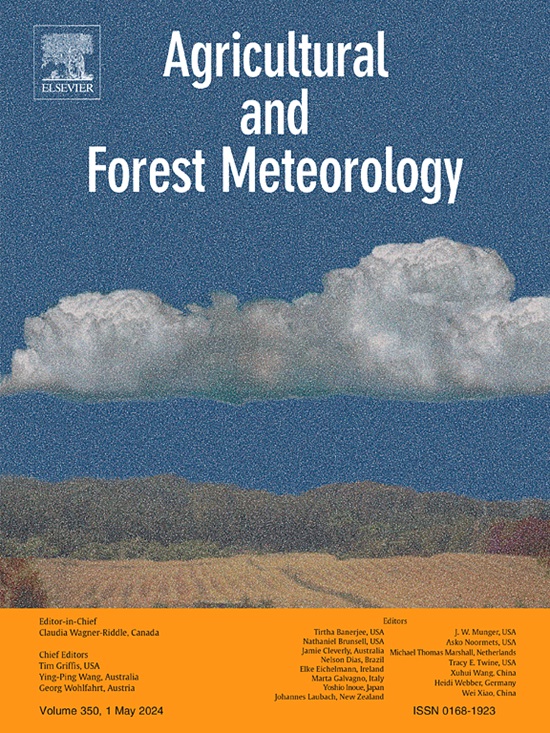揭示气候变化下中国森林火灾的未来变化
IF 5.6
1区 农林科学
Q1 AGRONOMY
引用次数: 0
摘要
在全球变化的推动下,森林火灾已成为未来日益严重的问题。为了减轻这种不确定性,了解气候变化下森林火灾的预估响应模式可以提供有价值的见解,特别是在像中国这样容易发生森林火灾且对气候变化高度敏感的地区。本研究采用随机森林算法建立了中国森林火灾发生概率、烈度和烧毁面积的预测模型。将这些模式应用于SSP1-2.6、SSP2-4.5和SSP5-8.5情景下的未来气候模拟,提供了中期(2041-2060)和长期(2081-2100)的预测,并与基线期(2001-2020)进行了对比分析,以评估相对变化。结果表明,到本世纪末,预计中国60% ~ 70%的森林面积将面临火灾风险增加,平均增幅不超过20%,大多数低风险区仍处于低风险区。然而,在SSP5-8.5的长期尺度下,大兴安岭、中部和东南部丘陵地区以及滇西高原峡谷等热点地区向中度或高度火灾风险的转变尤为显著。虽然大多数火灾易发地区的火灾强度预计将保持在中低水平,但中国西南地区可能会出现局部加剧。预计燃烧面积的增加将是广泛的,覆盖63%至64%的火灾易发地区,其中最大的增长发生在中期和SSP5-8.5以下。与南方地区相比,东北地区燃烧面积增加的地区比例较小,但总体增加较大,表明特定地区的火灾更加集中。这些发现揭示了中国不同森林火灾特征的不同未来变化轨迹,为全面考虑和整合前瞻性、科学可靠的国家防火规划提供了重要信息。本文章由计算机程序翻译,如有差异,请以英文原文为准。
Revealing future changes in China’s forest fire under climate change
Forest fires, driven by global change, have become an increasingly severe concern for the future. To mitigate this uncertainty, understanding the projected response patterns of forest fires under climate change can provide valuable insights, especially in regions like China, where forest fires are prone to occur and highly sensitive to climate variations. This study used the Random Forest algorithm to develop predictive models for occurrence probability, intensity levels, and burned area of forest fires in China. These models were applied to future climate simulations under SSP1–2.6, SSP2–4.5, and SSP5–8.5 scenarios, providing predictions for the mid-term (2041–2060) and long-term (2081–2100) periods with a comparative analysis against the baseline period (2001–2020) to assess relative changes. Results show that, by the end of the century, 60 % to 70 % of forested areas in China are projected to face increased fire risk, with the average percentage increase not exceeding 20 %, and most low-risk areas remaining at low risk. Nevertheless, the transition to moderate or high fire risk is particularly significant in the long term under SSP5–8.5, with hotspots such as the Greater Khingan Mountains, central and southeastern hilly regions, and the gorges of the western Yunnan Plateau. While fire intensity in most fire-prone areas is projected to remain at medium-to-low levels, localized intensification is possible in southwestern China. The increase in burned areas is projected to be widespread, covering 63 % to 64 % of fire-prone areas, with the greatest growth occurring in the mid-term and under SSP5–8.5. Compared to the southern regions, northeastern China shows a smaller proportion of areas experiencing increased burned areas but a larger total increase, indicating more concentrated fires in specific areas. These findings reveal the distinct future trajectories of different forest fire characteristics with regional variability in China, offering critical information for their comprehensive consideration and integration into forward-looking, scientifically robust national fire prevention planning.
求助全文
通过发布文献求助,成功后即可免费获取论文全文。
去求助
来源期刊
CiteScore
10.30
自引率
9.70%
发文量
415
审稿时长
69 days
期刊介绍:
Agricultural and Forest Meteorology is an international journal for the publication of original articles and reviews on the inter-relationship between meteorology, agriculture, forestry, and natural ecosystems. Emphasis is on basic and applied scientific research relevant to practical problems in the field of plant and soil sciences, ecology and biogeochemistry as affected by weather as well as climate variability and change. Theoretical models should be tested against experimental data. Articles must appeal to an international audience. Special issues devoted to single topics are also published.
Typical topics include canopy micrometeorology (e.g. canopy radiation transfer, turbulence near the ground, evapotranspiration, energy balance, fluxes of trace gases), micrometeorological instrumentation (e.g., sensors for trace gases, flux measurement instruments, radiation measurement techniques), aerobiology (e.g. the dispersion of pollen, spores, insects and pesticides), biometeorology (e.g. the effect of weather and climate on plant distribution, crop yield, water-use efficiency, and plant phenology), forest-fire/weather interactions, and feedbacks from vegetation to weather and the climate system.

 求助内容:
求助内容: 应助结果提醒方式:
应助结果提醒方式:


